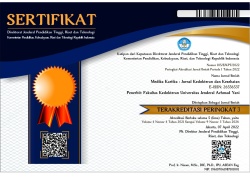PEMBERIAN PROPOLIS MEMENGARUHI PROFIL LIPID PADA TIKUS MODEL Polycystic Ovary Syndrome (PCOS)
Abstract
Polycystic Ovary Syndrome (PCOS) adalah suatu kelainan endokrin dan metabolik yang ditandai dengan anovulasi, hiperandrogenisme, dan gambaran polikistik pada ovarium. Etiologi PCOS belum pasti, diduga erat kaitan dengan stres oksidatif, dislipidemia, dan resistensi insulin. Propolis mengandung antioksidan, dapat menghambat proses peroksidasi lipid. Tujuan penelitian ini untuk mengetahui pengaruh propolis terhadap profil lipid. Penelitian ini adalah penelitian eksperimental menggunakan sebanyak 25 ekor tikus Wistar betina, berumur 13 minggu, berat badan 100-130 gram, sehat, usapan vagina normal, dan tidak hamil. Sampel dibagi menjadi lima kelompok yaitu K1 (kontrol negatif/normal), dan K2 (kontrol positif/PCOS), kelompok perlakuan P1, P2, dan P3 (PCOS+ propolis pada masing-masing kelompok dosis 50, 100, dan 200 mg/kgBB sekali per hari secara oral selama 14 hari). Induksi tikus model PCOS dilakukan dengan injeksi intraperitoneal Testosteron Propionat 1,8 mg/kbBB/hari dan diet HFHF selama 21 hari. Tikus dipuasakan 12 jam dilanjutkan dengan pemeriksaan profil lipid serum. Metode uji One Way Anova dan uji Kruskal-Wallis digunakan dalam uji statistik untuk mengetahui perbedaan antar kelompok. Hasil penelitian menunjukkan propolis secara bermakna (p<0,05) memiliki kemampuan menurunkan kadar kolesterol total, Low Density Lipoprotein (LDL) dan trigliserida serta meningkatkan kadar High Density Lipoprotein (HDL). Propolis dosis 100 mg/kgBB sekali per hari paling efektif bermakna (p <0,05) menurunkan kadar kolesterol total, sedangkan pada penurunan kadar LDL dan trigliserida serta peningkatan kadar HDL tidak ada dosis efektif . Propolis mampu menurunkan kadar kolesterol total, LDL dan trigliserida serta menaikkan kadar HDL pada tikus model PCOS.
Kata kunci: antioksidan, PCOS, profil lipid, propolis
References
2. Azziz R. Polycystic Ovary Syndrome. Obstet Gynecol. 2018 Aug;132(2):321–36.
3. Fauser BCJM, Tarlatzis BC, Rebar RW, Legro RS, Balen AH, Lobo R, et al. Consensus on women’s health aspects of polycystic ovary syndrome (PCOS): the Amsterdam ESHRE/ASRM-Sponsored 3rd PCOS Consensus Workshop Group. Fertil Steril. 2012 Jan;97(1):28-38.e25.
4. Rosenfield M. Computer vision syndrome (a.k.a. digital eye strain). Optom Pract [Internet]. 2016;17(1):1–10. Available from: https://www.researchgate.net/publication/295902618
5. Nandi A, Chen Z, Patel R, Poretsky L. Polycystic Ovary Syndrome. Endocrinol Metab Clin North Am. 2014 Mar 1;43:123–47.
6. Morang MD, Chasta P, Chandrul MKK. A Review on “Polycystic Overy Syndrom PCOS.” Int J Trend Sci Res Dev. 2019;Volume-3(Issue-4):60–6.
7. Brosens I, Benagiano G. Menstrual preconditioning for the prevention of major obstetrical syndromes in polycystic ovary syndrome. Am J Obstet Gynecol. 2015 Oct;213(4):488–93.
8. Sirait BI. Sindroma Ovarium Polikistik dan Infertilitas. J Ilm WIDYA [Internet]. 2018;5(3):1–6. Available from: http://repository.uki.ac.id/id/eprint/1691%0Ahttp://inajog.com/index.php/journal/article/view/849
9. Mohammadi M. Oxidative Stress and Polycystic Ovary Syndrome: A Brief Review. Int J Prev Med. 2019;10:86.
10. DiPiro JT, Talbert RL, Yee GC, Matzke GR, Wells BG, Posey LM. Pharmacotherapy: A Pathophysiologic Approach, Tenth Edition [Internet]. McGraw Hill LLC; 2017. Available from: https://books.google.co.id/books?id=BwF9DQAAQBAJ
11. Luo X, Cai WY, Wu XK. Prevalence, Pattern and Predictors for Dyslipidemia of Chinese Women With Polycystic Ovary Syndrome. Front Cardiovasc Med. 2021;8:790454.
12. Fulghesu A, Magnini R, Portoghese E, Angioni S, Minerba L, Melis GB. Obesity-related lipid profile and altered insulin incretion in adolescents with polycystic ovary syndrome. J Adolesc Heal Off Publ Soc Adolesc Med. 2010 May;46(5):474–81.
13. Lath R. Insulin resistance and lipid profile in polycystic ovary syndrome. Asian J Biomed Pharm Sci. 2015 Aug 5;05:30–5.
14. Bennett WL, Aschmann HE, Puhan MA, Robbins CW, Bayliss EA, Wilson R, et al. A benefit-harm analysis of adding basal insulin vs. sulfonylurea to metformin to manage type II diabetes mellitus in people with multiple chronic conditions. J Clin Epidemiol. 2019 Sep;113:92–100.
15.Woźniak Magdalena, Mrówczyńska Lucyna, Waśkiewicz Agnieszka, Rogozińsk Tomasz. 2019. Phenolic Profile and Antioxidant Activity of Propolis Extracts From Poland. sagepub. com/ journals- permissions. DOI: 10.1177/1934578X19849777. journals. sagepub. com/ home/ npx. 1-7.
16.Zullkiflee N, Taha H, Usman A. Propolis: Its Role and Efficacy in Human Health and Diseases. Vol. 27, Molecules. 2022.
17. Abdullah NA, Ja’afar F, Yasin HM, Taha H, Petalcorin MIR, Mamit MH, et al. Physicochemical analyses, antioxidant, antibacterial, and toxicity of propolis particles produced by stingless bee Heterotrigona itama found in Brunei Darussalam. Heliyon. 2019 Sep;5(9):e02476.
18. Bonamigo T, Campos JF, Alfredo TM, Balestieri JBP, Cardoso CAL, Paredes-Gamero EJ, et al. Antioxidant, Cytotoxic, and Toxic Activities of Propolis from Two Native Bees in Brazil: Scaptotrigona depilis and Melipona quadrifasciata anthidioides. Oxid Med Cell Longev. 2017;2017.
19. Stojanovic S, Najman S, Bogdanova Popov B, Najman S. Propolis Chemical Composition, Biological, and Pharmacological Activity - A- Review. Acta Medica Median. 2020 Jun 15;59:108–13.
20. Wali AF, Avula B, Ali Z, Khan IA, Mushtaq A, Rehman MU, et al. Antioxidant, Hepatoprotective Potential and Chemical Profiling of Propolis Ethanolic Extract from Kashmir Himalaya Region Using UHPLC-DAD-QToF-MS. González Gallego J, editor. Biomed Res Int [Internet]. 2015;2015:393462. Available from: https://doi.org/10.1155/2015/393462
21. Huang S, Zhang CP, Wang K, Li GQ, Hu FL. Recent advances in the chemical composition of propolis. Molecules. 2014 Nov;19(12):19610–32.
22. Parwata MO, Bahan Ajar Kimia Organik Bahan Alam. 2014;1–39.
23. Abbasi E, Bagherniya M, Soleimani D, Ghasemi-Tehrani H, Abbaspour M, Clark CCT, et al. The effects of propolis supplementation on high-sensitivity C-reactive protein, testosterone hormone, and metabolic profile in women with polycystic ovary syndrome: A randomized, triple-blinded, placebo-controlled clinical trial. Phyther Res [Internet]. 2023 Nov 1;37(11):5366–77. Available from: https://doi.org/10.1002/ptr.7977
24. Ahmed, Shehab E, Ibraheem, R S, Al-bari, Abid HI. Using of Propolis on the treated rats induced with Polysystic ovarian syndrome by Litrozol drug. Bull Natl Inst Heal Sci [Internet]. 2022;140(08):3083–94. Available from: https://www.healthsciencesbulletin.com/volume/BNIHS/140/08/using-of-propolis-on-the-treated-rats-induced-with-polysystic-ovarian-syndrome-by-litrozol-drug-637c98a6abc82.pdf
25. Ali A, Paramanya A, Poojari P, Arslan-Acaroz D, Acaroz U, Kostić AŽ. The Utilization of Bee Products as a Holistic Approach to Managing Polycystic Ovarian Syndrome-Related Infertility. Nutrients. 2023 Feb;15(5).
26. Krentowska A, Kowalska I. Metabolic syndrome and its components in different phenotypes of polycystic ovary syndrome. Diabetes Metab Res Rev. 2022 Jan;38(1):e3464.
27. Mujica V, Orrego R, Pérez J, Romero P, Ovalle P, Zúñiga-Hernández J, et al. The Role of Propolis in Oxidative Stress and Lipid Metabolism: A Randomized Controlled Trial. Evid Based Complement Alternat Med. 2017;2017:4272940.
28. Jia Yanwen, Jiang Shengqun, Chen Chen, Lu Guohua. 2019. Caffeic Acid Phenethyl Ester Attenuates Nuclear Factor‑κB‑Mediated Inflammatory Responses in Müller Cells and Protects Against Retinal Ganglion Cell Death. Molecular Medicine Report. DOI: 10.3892/mmr.2019.10151.
29. Anjum, S. I., Ullah, A., Khan, K. A., Attaullah, M., Khan, H., Ali, H., Bashir, M. A., Tahir, M., Ansari, M. J., Ghramh, H. A., Adgaba, N., & Dash, C. K. 2019. Composition and functional properties of propolis (bee glue): A review. Saudi Journal of Biological Sciences, 26(7), 1695–1703. https://doi.org/10.1016/j.sjbs.2018.08.013
30. Nna, V.U.; Abu Bakar, A.B.;Zakaria, Z.; Othman, Z.A.; Jalil, N.A.C.; Mohamed, M. 2021. Malaysian Propolis and Metformin Synergistically Mitigate Kidney Oxidative Stress and Inflammation in Streptozotocin-Induced Diabetic Rats. Molecules , 26, 3441. https://doi.org/10.3390/molecules26113441



























